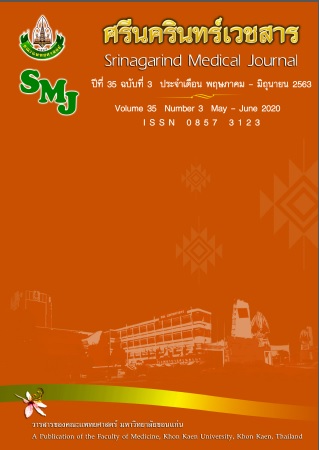Efficacy and Safety of Dispensing System by Pharmacy Robot and Handset Electronic Picking in Hospitalized Patients at Srinagarind Hospital
Keywords:
Pharmacy robot; Handset electronic picking; Robotic medicineAbstract
Background and Objective: The technology machines was used for filling the medicines for hospitalized patients at Srinagarind Hospital. The objective of this study was to evaluate efficacy and safety of dispensing system by pharmacy robot and handset electronic picking.
Methods: This was a retrospective descriptive study. Drug prescriptions, dispensing items, waiting time, and dispensing errors were compared between before and after implementation of the robotic medicine and handset electronic picking for continued order items, narcotics and psychotropics category 2 items while other items were filled manually for hospitalized patients.
Results: Mean waiting time for overall prescriptions was not significantly different between pre- and post- intervention (15.9 vs. 15.5 minutes per prescription). The mean waiting time for continued order prescriptions significantly increased 21.5% (0.7 vs. 0.8 minutes per item). The increased waiting time for continued order items occurred in the process of pharmacist checking since the continued order items increased 51.4% in the post- intervention period (666,888 vs. 1,009,667 items) and drug distribution system was changed from three days dose to one day dose which led to decreasing time for nurse to prepare medications for patients. The mean waiting time for stat order item significantly decreased 14.4% (14.9 vs. 12.8 minutes per item). For other subtype of prescription, no significant change of waiting time was found. Dispensing error significantly decreased 51.1% of prescriptions or 52.3% of items. The largest decrease in dispensing error was found in continued order items (77% decreased). Dispensing errors with severity category B and C decreased 50.3% and 89.1% of items.
Conclusions: Implementation of pharmacy robot and handset electronic picking of drug dispensing improved efficacy, dispensing errors, and patient safety for hospitalized patients.
References
2. กรัณฑ์รัตน์ ทิวถนอม, ศุภลักษณ์ ธนานนท์นิวาส. ความคลาดเคลื่อนทางยาและแนวทางป้องกันเพื่อความปลอดภัยของผู้ป่วย. Veridian E-Journal 2552; 2: 196-7.
3. สมาคมเภสัชกรรมโรงพยาบาล (ประเทศไทย). มาตรฐานวิชาชีพเภสัชกรรมโรงพยาบาล พ.ศ. ๒๕๖๑ - พ.ศ. ๒๕๖๕ [Online].[Accessed July 27, 2019]. Available from http://www.thaihp.org/index.php?option=other_detail&lang=th&id=307&sub=-1
4. Rough SR, Temple JD. Automation in practice. In: Brown TR, ed. Handbook of institutional pharmacy practice. 4th ed. Bethesda, MD: American Society of Health-System Pharmacist, 2006: 329-52.
5. Fitzpatrick BR, Cooke P, Southall C, Kauldhar, Water P. Evaluation of an automated dispensing system in a hospital pharmacy dispensing. Pharm J. 2005; 274: 763-5.
6. National Coordinating Council for Medication Errors Reporting and Prevention. NCC MERP Taxonomy of Medication Errors [Online]. [Accessed August 6, 2019]. Available from http://www.nccmerp.org/sites/default/files/taxonomy2001-07-31.pdf
7. Goundrey-Smith S. Pharmacy robots in UK hospitals: the benefit and implementation issues. Pharm J 2008; 280: 599-602.
8. Temple J and Ludwig B. Implementation and evaluation of carousel dispensing technology in a university medical center pharmacy. Am J Health-Syst Pharm 2010; 67: 821-9.
9. Ong YSP, Chen LL, Wong JA, Gunawan Y, Goh WJ, Tan MC, Lee SB. Evaluating the Impact of Drug Dispensing Systems on the Safety and Efficiency in a Singapore Outpatient Pharmacy. Innov Pharm 2014; 5: 1-7.
10. วรรณอร ปลอดกระโทก, ฐณัฎฐา กิตติโสภี, รุ่งเพ็ชร์ สกุลบำรุงศิลป์, กมลศักดิ์ เรืองเจริญรุ่ง. การหาต้นทุนที่ประหยัดและต้นทุนที่หลีกเลี่ยงได้ของระบบจ่ายยาอัตโนมัติ. วารสารเภสัชกรรมโรงพยาบาล 2553; 20: 43-54.



